Mating with a single rook is the easiest way to deliver a checkmate. And as a beginner, mastering such checkmates is one way to get better at the game.
I hear you saying – “Isn’t mating with the queen the easier? After all, the queen is more powerful than the rook?”
Yes, the queen is a more powerful piece than the rook. But with so much power comes great responsibility.
With the queen, the possibility of a stalemating increase. A stalemate ends in a draw. I have seen this happen so many times whenever I used to teach beginners how to checkmate.
On the other hand, checkmating a bare king with the rook is easier to master as a beginner. Once you understand this technique, checkmating with the queen will be 100x simpler.
Contents
The Strategy
- The rook creates smaller boxes to corner the opposing king.
- The king of the stronger side supports his rook so that the opposition king can’t capture it for free.
- When the rook is ideally placed, it’s time to bring the king forward so that the king can support the rook’s future operation to shorten the box even further.
- When progress can’t be made, play a waiting move with the king.
- Box the opposing king until it has only 2 squares to move. When it has only 2 squares left, go in for the kill and deliver a checkmate.
From my experience, for a beginner, the first three are easy to master and understand. For the remaining two, you’ll get better with practice.
Before we move on to the technique, I suggest you keep a chessboard ready. It will help you remember and master this technique easily.
Example for Checkmating with a Rook and King
Position
White : Ke1 Rh1
Black : Ke5

The Black king is in the center of the board and White’s pieces are not placed optimally. Let’s learn how to checkmate the Black king from this position.
The Technique – Boxing Technique
Use the boxing technique to make shorter boxes with the rook and restrict the Black king to one corner of the board. You’ll understand what I mean.
White plays
1. Rh4!

Cutting off the Black king from the fourth file. Notice the box which is created : h4-a4:a4-h8. The Black king is restricted within this box. He cannot make it to the other side of the board.
White’s strategy is to keep shortening the box with the help of his king until the Black king is in a corner of the board.
Black plays
1… Kd5 (staying in the centre)
Now White must bring his king forward to help his rook create shorter boxes. Notice how White does this.
2. Ke2 Ke5
3. Ke3 Kd5
Black king stays in the centre. Now White’s king can support the rook to create a shorter box. How would you do it? Try to find before you look for the next move.
4. Re4!
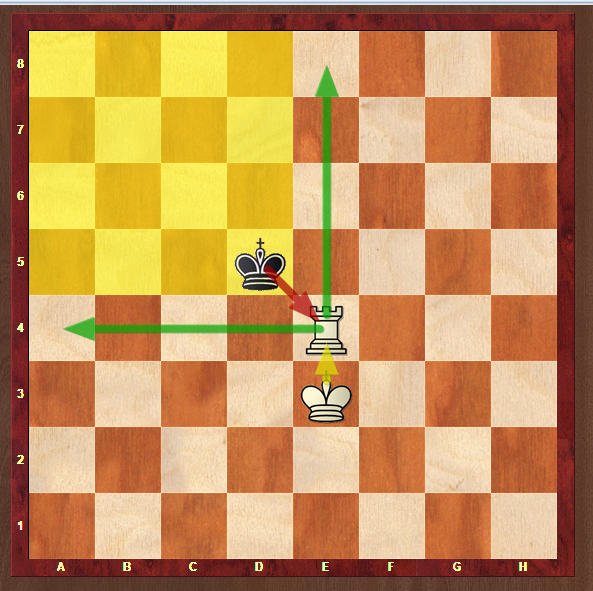
A key position.
The White rook has shortened the box – e4-a4:e4-e8.
The Black king is restricted to this box.
The White king supports his rook because of which Black’s king can’t capture the rook. That’s an important role the White king plays. Without the White king’s support it would be impossible for the single rook to deliver a checkmate.
(4. Rd4+ is a perfectly fine alternative when after 4…Ke5 the Black king is again restricted in a box – d4-d8:d4-h4)
Pro Tip : Visualize the box where the weaker king is located.
In 4. Re4!, the Black king is on d5, so our box is e4-a4:e4-e8. If the Black king is on f5 and White rook is on e4, the box is e4-h4:e4-e8.
Moving on, after 4. Re4!, Black plays
4… Kc5
And White continues to shorten the box.
There are other alternatives which Black can play. But first, let’s understand the technique. I promise once you get the technique, you yourself would find a solution to checkmate the Black king.
5. Rd4 (shorten the box – d4-a4:d4-d8)
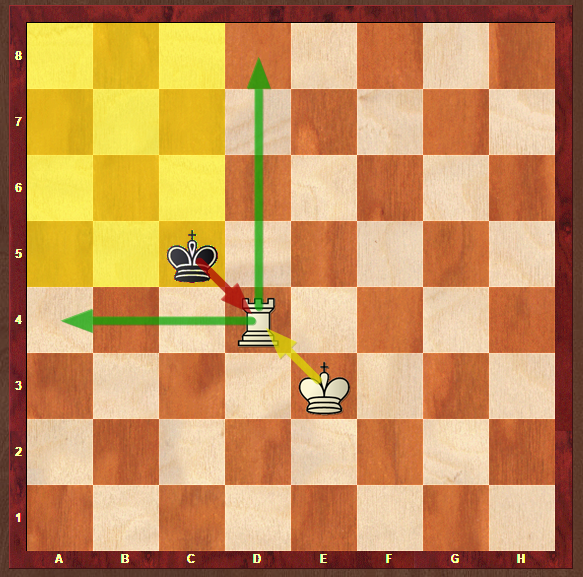
5… Kb5
6. Kd3 (bring the king) Kc5
The king marches forward!
7. Kc3!
The correct move.
(7. Rc4+ would be bad as the Black king steps into a bigger box after 7…Kd5.
The new box would be bigger – c4-h4:c4-c8.)
Remember our goal is to keep shortening the box, not keep making it larger.
After 7. Kc3, Black plays –
7… Kb5
8. Rc4!(shorten the box) Kb6
Now the White rook is ideally placed but it can’t make any progress further. Hence the White king charges forward to help his rook shorten the box.
9. Kb4!
Marching forward!
9… Kb7
The Black king is pushed back.
10. Kb5 (diagram)

Forward again!
10… Ka7
The Black king wants to hold off the advance. Now we use the rook again to shorten the box.
11. Rc6
The box is shortened even more c6-a6:c6-c8. The Black king has only 4 squares left to move. 11. Rc7+ is a faster way to checkmate which any pro would spot. But mastering the technique, as a beginner is more important. Once you have a solid technique, you’ll understand these little details yourself.
When to play waiting moves?
11… Kb7 (diagram)
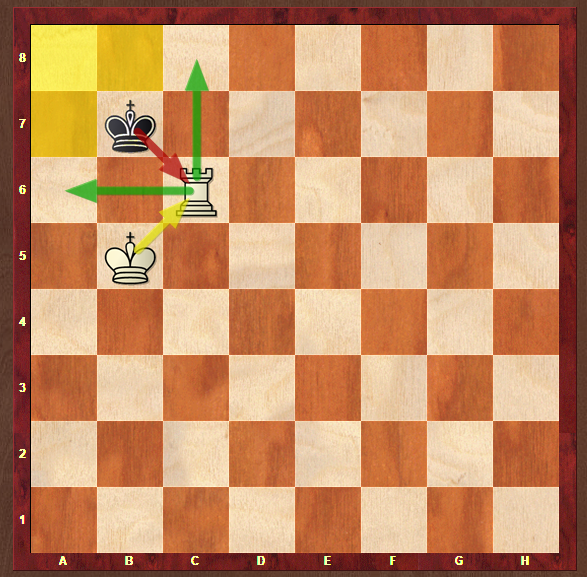
Pay careful attention to this part. Now what to do? The rook is ideally placed. You wish it were your opponent’s move so that he could weaken his position somehow.
Aha! That means you’ve to wait. You’ve to make a waiting move!
But you can’t move your rook as it’d make the box bigger. So what do you do? You move the other piece, the king, while at the same time keep the rook supported. And there’s only one square to do that.
12. Kc5! (diagram)

A very important move. When your rook is ideally placed and you can’t find a way to make progress, make a waiting move with the king.
Now Black has to move his King and worsen his position.
12… Ka7
Reaching the dream position before checkmating
13. Rb6 (diagram)

The aim of shortening the box is successful (b6-a6:b6-b8). The Black king has only 2 squares left to move. This is the ideal situation to have. Now it’s time to bring the king forward to deliver a checkmate.
15… Ka8
The White king marches forward to cut off the important squares from the Black king.
16. Kc6 Ka7
17. Kb6(diagram)
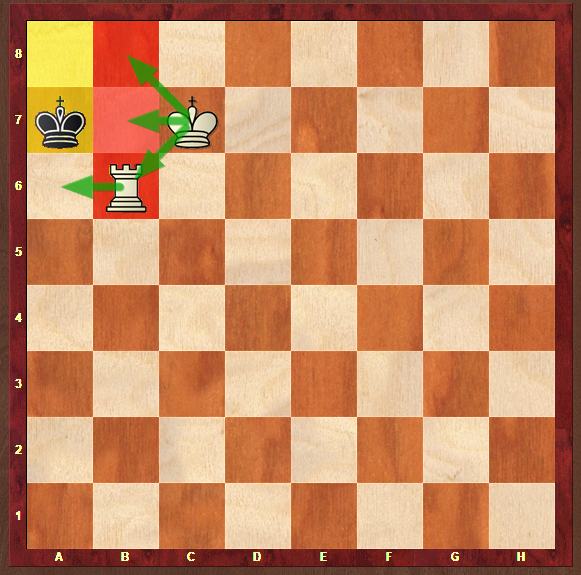
17… Ka8
And now comes the checkmate.
18. Ra6# (diagram)
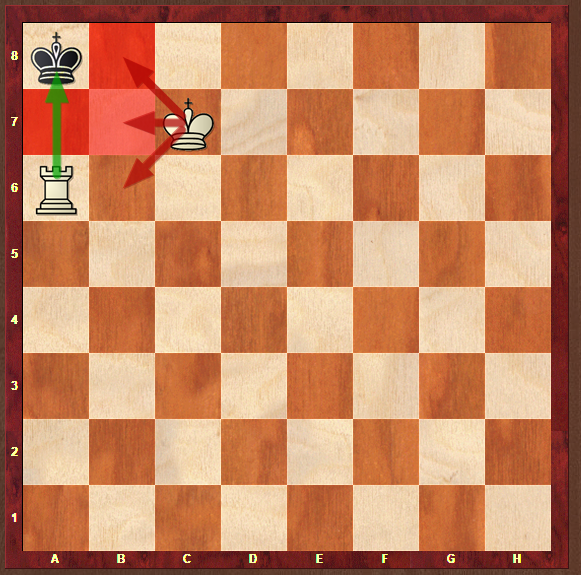
Notice that shortening the box further with 18.Rb7(b7-a7:b7-a8) would lead to a stalemate.
This is a very common mistake among the beginners. Try to avoid it.
Pro Tip : Shorten the box up to a point where the opposing king has at least 2 squares to move. This way you wouldn’t make a stalemate.
How to improve checkmating with the rook?
Practice checkmating with the rook and king vs king against a friend or a computer. You can also practice this mate on online platform like
How many days will it take you to master single rook mate?
With enough practice, it should take you 2-3 days to master the single rook mate. It’s simple and it’s one of the most basic things you must know if you want to win a game of chess.
Like I said before, with practice it will become as easy as breathing.
I hope this helps you to master the rook + king vs king checkmate. Keep practicing and reread this article until you fully master the checkmating technique.
Good luck!

Highly Recommended for begineers!
Thank you Nikhil!